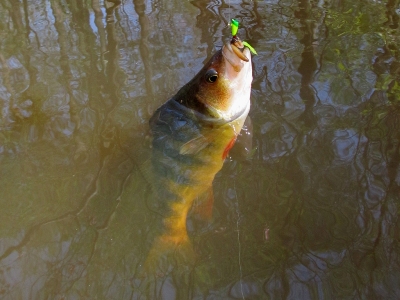
Yellow perch are found throughout Maryland in lakes, reservoirs, rivers, creeks, and streams. Also known as ringed perch, these colorful fish are famous for their spring spawning runs.
Tidal River Fishing
Rivers and creeks contain some of the most productive fishing for yellow perch in Maryland.
Although yellow perch can be caught almost year-round, the majority of fishing effort is focused on spring spawning runs which begin tidal river systems.
Several Eastern Shore rivers are noted for their yellow perch fisheries, including the Chester, Wye, Sassafras, Choptank, Nanticoke, Wicomico, and Pocomoke.
On the Western Shore, the Gunpowder, Patapsco, Patuxent, and Potomac rivers are known for spawning runs of yellow perch.
Seasonal yellow perch habitats vary among rivers, with each watershed having its own unique combination of winter, spawning, and warm season structure.
A typical tidal river yellow perch spawning cycle begins long before the first signs of spring. In late winter, yellow perch gather in large schools along deep river areas. Although this usually occurs during the coldest part of the winter, a few anglers target perch with good success during this phase.
By late winter, water temperatures begin to rise, triggering yellow perch to begin moving upstream. During this stage, yellow perch may move into fishing areas almost overnight.
As the days grow longer, the fish become restless and move into small freshwater creeks and streams to spawn. After spawning, many yellow perch remain high up in river systems where they feed on small fish, crayfish, and other prey.
Fishing for yellow perch during their spring migrations can be challenging. During the early season, anglers often encounter bitter cold. As the migration unfolds, fishing in a given location can be hot one day and slow the next.
Throughout the late winter and spring season, anglers may experience fluctuations in weather, water conditions, and numbers of fish. Despite the array of factors that work against success, when anglers find themselves in the right place at the right time, fishing for tidal yellow perch can be red hot.
By mid-April to mid-May, spawning in most areas is complete. Although the fish are dispersed throughout watersheds, action can still be good as fish feed heavily. Success during this phase is highly dependent on both location and technique.
In many areas, yellow perch are highly selective in their feeding patterns. This can result in angler frustration as perch may be literally right under the boat and not bite unless a correct presentation or bait or lure is made.
One of the more effective techniques for post-spawn yellow perch fishing is to fish a live bait, lure, or combination very slowly along the bottom. Although this sounds simple, habitat usually presents a considerable challenge to the angler.
In many areas, post-spawn yellow perch thrive in hard to reach areas where stumps, fallen trees, and other obstructions dominate the bottom. These conditions require considerable patience and a high level of angler skill.
The most effective lures and baits for fishing in these conditions are usually simple. Shad darts, crappie jigs, and other inexpensive lures are popular as are small to mid-sized weedless soft plastics. When yellow perch are feeding on crayfish or other bottom dwellers, lures may need to be bounced along the bottom in order to be effective.
Anglers often entice yellow perch by combining jigs or other tackle with live or cut baits. Minnow-jig combos are popular as well as simply dressing jigs with small pieces of nightcrawlers or other baits. For bait-only anglers, rigs that incorporate floating jig heads, small circle hooks, or other tackle are popular. In most areas, the habitat will dictate which rigs and lures can be used effectively.
Yellow perch are one of several species that migrate into Maryland tributaries to spawn. Among the other spawning fish are striped bass, white perch, American shad, hickory shad, and river herring.
Depending on location, timing, and water conditions, anglers may find themselves among only one or several of these fish. Because of this phenomenon, anglers sometimes choose lures that are likely to be accepted by multiple species of fish.
Lakes, Reservoirs, and Ponds
Throughout Maryland, man-made impoundments sustain populations of yellow perch. These range from large reservoirs to rural mill ponds, borrow pits, and other waters. In some cases, yellow perch populations are the result of state-run fish stocking programs. In other impoundments, yellow perch occur naturally. In many Maryland lakes, yellow perch can be caught year-round.
A key factor in the success of yellow perch in Maryland’s reservoirs lies in the physical structure of each body of water. Most large impoundments are part of a complex watershed that may include headwaters, feeder streams, and other tributaries.
Below reservoirs, rivers provide migratory pathways for wild populations of perch. Although dams and other man-made structures have traditionally blocked passage of yellow perch, many reservoirs are now equipped with some form of fish passage technology.
During the spawning season, anglers fishing in Maryland’s lakes and reservoirs find that many of the same concepts that apply to river fishing work well in freshwater. As with river fish, freshwater yellow perch usually stage in deep water in late winter before moving into spawning habitats.
As the spring season progresses, anglers often encounter yellow perch in feeder creeks and streams. During the fall season, perch return to deep areas of their home lake. In some parts of Maryland, yellow perch fishing continues during the winter, even when lakes ice over. When the ice fishing season ends, the cycle begins again for the next season.